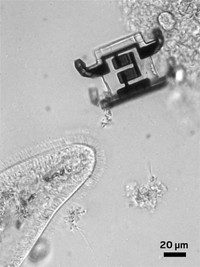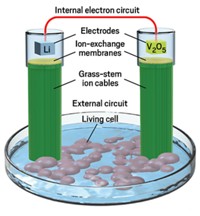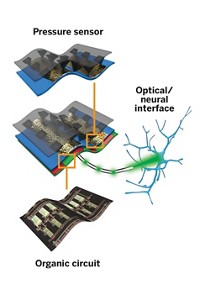Advertisement
Grab your lab coat. Let's get started
Welcome!
Welcome!
Create an account below to get 6 C&EN articles per month, receive newsletters and more - all free.
It seems this is your first time logging in online. Please enter the following information to continue.
As an ACS member you automatically get access to this site. All we need is few more details to create your reading experience.
Not you? Sign in with a different account.
Not you? Sign in with a different account.
ERROR 1
ERROR 1
ERROR 2
ERROR 2
ERROR 2
ERROR 2
ERROR 2
Password and Confirm password must match.
If you have an ACS member number, please enter it here so we can link this account to your membership. (optional)
ERROR 2
ACS values your privacy. By submitting your information, you are gaining access to C&EN and subscribing to our weekly newsletter. We use the information you provide to make your reading experience better, and we will never sell your data to third party members.
Materials
How materials chemistry is advancing the optogenetics revolution
Neuroscience is getting an assist from flexible optoelectronics
by Matt Davenport
February 6, 2017
| A version of this story appeared in
Volume 95, Issue 6

Optogenetics has ignited a revolution in neuroscience.
Although this decree may sound like hype, researchers in the field disagree, saying the technique is allowing them to understand brain function and disorder with unprecedented precision.
In optogenetics studies, scientists modify specific cells in the nervous systems of lab animals to respond to light. By shining light into these cells, researchers can observe how stimulating specific neural circuits affects the behavior of animals, from how they move to how they interact.
But the revolution is young and, in some senses, bridled.
For instance, funneling light into the brains of animals covered with nontransparent tissue—most often mice and rats—is a challenge. Typically, researchers overcome this challenge by surgically inserting a slender fiber optic cable into an animal’s brain. The embedded cable is secured to the animal’s head with a bulky plastic cap, and the opposite end is connected to a laser.
The system works, but it can create serious complications for animals and questions for researchers about the behaviors they’re observing in their lab animals. So chemists and materials scientists are joining the optogenetics cause to liberate the field from its constraints and push the technology to new levels.
The protocols using fiber optics are vetted by animal care committees, but cables aren’t the best things to be sticking into brains from a materials standpoint, says John A. Rogers of Northwestern University.
Although optical fibers may seem tiny to humans, “to a small mouse, a fiber optic is basically a big cylindrical chunk of glass,” Rogers explains. “As a materials chemist, you want to move away from hard things to soft, compliant things” for embedding in tissue, he says.
Inserting hard glass into soft, compliant brain tissue can lead to irritation and inflammation. Infection is also a concern because the cable must exit the mouse’s body to connect to an external light source, leaving a physical opening in the animal for opportunistic bacteria to invade.
Although the headpieces used in conventional optogenetics studies can mitigate infection and irritation, the plastic caps can be cumbersome, especially for mice, and the burden affects how they behave. Optogenetics researchers want to understand animal behavior, so having the method influence the outcome is far from ideal.
The animal is also tethered by the cable to a laser, restricting where it can and can’t go. Cables can get tangled with all sorts of things in the lab, including running wheels and other animals.
To clear these pitfalls, Rogers wanted to create cable-free, completely implantable systems using light-emitting diodes (LEDs). Working with neuroscientists at Washington University in St. Louis, that’s exactly what he and his colleagues have done (Neuron 2017, DOI: 10.1016/j.neuron.2016.12.031).
The team commercialized its system last year, and the researchers have been showcasing the technology at scientific meetings since. More than 300 neuroscientists have requested access to the technology, with more requests coming in weekly, says Michael R. Bruchas, a leader of one of the St. Louis labs on the team.
Rogers showed off the devices in November at the annual fall meeting of the Materials Research Society in Boston. He stood at the front of a packed room, playing a video of a mouse that was entirely unremarkable, save for the light glowing from underneath its scalp. “I think this guy has no idea he has an LED in his brain,” Rogers said.
But the implant, about 1 cm in diameter, isn’t just for brains, Rogers says. The device can also slip its microscopic LED into spinal cords or periphery nerves, expanding the portfolio of what optogenetics researchers can study with a single device.

Rogers’s team hasn’t been the only one creating miniature implantable LED systems. For instance, Stanford University electrical engineer Ada S. Y. Poon and coworkers showed researchers how to make such devices using readily available electronic components, including circuit boards and solder (Nat. Methods 2015, DOI: 10.1038/nmeth.3536).
Rogers and his team adopted a different approach, turning to flexible materials made with techniques more scalable than soldering. In the team’s current device, electrodeposited copper is sandwiched between elastomeric polymer films and is coiled into a circular radio-frequency antenna to supply power. Jutting out from the inner ring of the antenna coil, a stretchable, serpentine copper wire connects to a microscopic inorganic LED near the center of the device.
Although organic LEDs (OLEDs) could have provided more inherently flexible devices, inorganic LEDs, such as those made of gallium nitride and gallium arsenide, can be made pliant by keeping them thin. Each LED is about 50 µm thick. They’re also more stable than OLEDs, which are notorious for deteriorating in watery conditions. Water is just one thing researchers have to worry about inside a brain.
Briny brain conditions are challenging even for inorganic LED systems. Rogers and his colleagues initially tried protecting their LEDs with a common technique used by the OLED display industry that involves encapsulating electronics with alternating layers of inorganic and organic compounds.
The idea is that defects in the dissimilar inorganic and organic materials misalign, preventing any corrosive substances from getting through to the sensitive electronic components. As it turns out, this approach offers insufficient protection inside the brain. So the team rethought its process and developed an alternative. Starting with atomically smooth silicon wafers, the team grows thin, transparent, but “completely impermeable” oxide layers, Rogers says (Proc. Natl. Acad. Sci. USA 2016, DOI: 10.1073/pnas.1605269113). The researchers can then build up the electronics so that their LEDs are shielded by silicon oxide layers.
When an LED fails, it’s not because water molecules or ions penetrate the oxide layer, Rogers explains. Rather, it’s because the entire layer has dissolved through hydrolysis—a process that would take six to seven decades for a roughly 1-µm-thick film under physiological conditions, according to the team’s accelerated aging tests.
Longevity is but one attractive feature to Cameron H. Good of the U.S. Army Research Laboratory. Good studies nerve agents, how to defend against them, and their long-term effects on brains and behavior. He’s one of the early adopters of the commercial implantable devices being sold by NeuroLux, a company started by Rogers and his Washington University colleagues.
Good also appreciates that he’s able to keep the animals untethered at all times now.
NeuroLux isn’t the first company to offer untethered systems for optogenetics, but earlier products still had bulky enclosures on top of an animal’s head to house certain components, such as light sources and batteries, Good explains. These headpieces, remember, can influence animal behavior. Rodents have been known to try to gnaw or knock headpieces off each other, he adds.
NeuroLux devices don’t appear to alter the behavior of the rodents in which they’re implanted or the behavior of their neighbors. Good says that the implant “will really open the door for a lot of social behavior studies that weren’t possible before.”
Good is still using his older fiber optics setups for now, too. These allow him to implant two fibers in one animal to shine two different colors of light and stimulate two different engineered cell types. But he adds that he’s working with Rogers to bring this capability to the cable-free implants.
Researchers interested in getting more information out of the brain with new materials for optogenetics are also seeing what they can make devices do beyond shine light. Dong-Wook Park, Zhenqiang (Jack) Ma, and Justin C. Williams first came together at the University of Wisconsin, Madison, to find out whether graphene could help further neuroscience.
Graphene’s electrical conductance per unit thickness is unbeatable; plus it’s chemically resilient, physically pliable, and virtually invisible, Ma explains. Put that all together, and you’ve got a great electrode material that can withstand physiological conditions while transmitting light.
Electrodes excite nerve cells indiscriminately, making them clunky probes for studying brain activity by themselves. But using the electrodes to record brain activity stimulated by light, thereby coupling electrophysiology with optogenetics, is a promising application, Park says.
Williams concedes that the need for transparent electrodes isn’t altogether pressing. Existing platinum electrodes can work with optogenetics in low numbers. But researchers are increasing the number of electrical contacts they’re able to make with tiny patches of brain, and that growing thicket can start blocking light pretty quickly.
Electrodes and wiring made with graphene four atoms thick can solve the problem, though. These carbon conductors are almost completely transparent across a wide range of wavelengths. This presents an opportunity to combine graphene’s electronic properties with not only optogenetics but also with a battery of imaging techniques. The graphene is even transparent to magnetic resonance imaging measurements.
Other scientists have noticed the electrodes’ versatility. “We’re getting requests to try all sorts of things we never thought about before,” Williams says. The team recently published a recipe on how to make the electrodes to help others integrate the technology into their own work (Nat. Protoc. 2016, DOI: 10.1038/nprot.2016.127).
Park, who’s now a postdoc at Stanford, wants to apply the technology to studies of epilepsy, Parkinson’s disease, and other nervous system disorders. Meanwhile, Ma and Williams are interested in pushing their electrodes to extremes in both construction and application, though they are careful not to share too many specifics.
Researchers are clearly thinking about how advanced materials can combine optogenetics and other techniques. In fact, it’s the “ands” that are perhaps most intriguing, says Kay M. Tye, an optogenetics expert at Massachusetts Institute of Technology.
For instance, she points to the combined imaging and electrophysiology capabilities of the electrodes. Another example is recent work from Rogers and his team that combines microfluidics and wireless LED implants, a union that could enhance pharmaceutical screening efforts.
Rogers, too, is excited by the ands. Optogenetics is just one of many applications for his implantable devices. The systems could expand to include chemical sensing and photodetection for spectroscopy, he says.
Currently, only a smattering of chemists and materials scientists are bringing their expertise to bear on the neuroscience revolution, Rogers says. But he hopes that contingent grows and accelerates the quest to understand our brains.





Join the conversation
Contact the reporter
Submit a Letter to the Editor for publication
Engage with us on Twitter